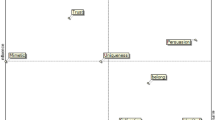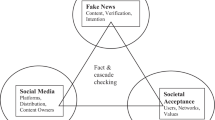Abstract
This commentary in response to Perloff (2014) suggests considerations for studying social media’s potential influence on body image. These are derived from Perloff’s transactional model of social media and body image. In investigating how social media use may influence body dissatisfaction in the United States, scholars should consider how the purposes and functions of social media differentiate them from traditional media effects theories. Individuals may be more likely to encounter unsought messages in social media than in traditional media. Social media messages have the potential to present much more diverse representations of female and male bodies because they are mostly produced and disseminated by individuals. Finally, social media offer the ability to reach a variety of at-risk groups with media literacy training. Media literacy training educates audiences about the purposes of messages, which can increase skepticism and possibly reduce message effects. Thus, media literacy training may address the media-related aspect of body dissatisfaction because it teaches critical and analytical skills. Theoretically driven models such as Perloff’s transactional model of social media and body image provide a fruitful basis of research.
Similar content being viewed by others
References
Agosto, D. E., & Magee, R. M. (2014). A promising future: U.S. public libraries as informal media literacy educators. In B. S. De Abreu & P. Mihailidis (Eds.), Media literacy education in action: Theoretical and pedagogical perspectives (pp. 103–109). New York: Routledge.
Berghoff, H., & Kühne, T. (2013). “It makes princes of those who have it”: Beauty and consumerism in the twentieth century. In H. Berghoff & T. Kühne (Eds.), Globalizing beauty: Consumerism and body aesthetics in the twentieth century (pp. 1–19). New York: Palgrave MacMillan.
Blashill, A. J. (2011). Gender roles, eating pathology, and body dissatisfaction in men: A meta-analysis. Body Image, 8, 1–11. doi:10.1016/j.bodyim.2010.09.002.
Bordo, S. (1993). Unbearable weight: Feminism, Western culture, and the body. Berkeley: University of California Press.
Borzekowski, D. L. G., Schenk, S., Wilson, J. L., & Peebles, R. (2010). e-Ana and e-Mia: A content analysis of pro-eating disorder web sites. American Journal of Public Health, 100, 1526–1534. doi:10.2105/AJPH.2009.172700.
Botta, R. A. (2003). For your health? The relationship between magazine reading and adolescents’ body image and eating disturbances. Sex Roles, 48, 389–399. doi:10.1023/A:1023570326812.
boyd, d. (2014). It’s complicated: The social lives of networked teens. New Haven: Yale University Press.
Brown, J. D., & Bobkowski, P. S. (2011). Older and newer media: Patterns of use and effects on adolescents’ health and well-being. Journal of Research on Adolescence, 21, 95–113. doi:10.1111/j.1532-7795.2010.00717.x.
Brumberg, J. J. (1992). From psychiatric syndrome to “communicable” disease: The case of anorexia nervosa. In C. E. Rosenberg & J. Golden (Eds.), Framing disease (pp. 134–154). New Brunswick, NJ: Rutgers University Press.
Brumberg, J. J. (1997). The body project: An intimate history of American girls. New York: Random House.
Buote, V. M., Wilson, A. E., Strahan, E. J., Gazzola, S. B., & Papps, F. (2011). Setting the bar: Divergent sociocultural norms for women’s and men’s ideal appearance in real-world contexts. Body Image, 8, 322–334. doi:10.1016/j.bodyim.2011.06.002.
Callaghan, G. M., Lopez, A., Wong, L., Northcross, J., & Anderson, K. R. (2011). Predicting consideration of cosmetic surgery in a college population: A continuum of body image disturbance and the importance of coping strategies. Body Image, 8, 267–274. doi:10.1016/j.bodyim.2011.04.002.
Cash, T. F. (2002). Women’s body images. In G. M. Wingood & R. J. DiClemente (Eds.), Handbook of women’s sexual and reproductive health (pp. 175–194). New York: Kluwer Academic/Plenum Publishers.
Chambers, K. L., & Alexander, S. M. (2007). Media literacy as an educational method for addressing college women’s body image issues. Education, 4, 490–497.
Chou, W.-Y. S., Hunt, Y. M., Beckjord, E. B., Moser, R. P., & Hesse, B. W. (2009). Social media use in the United States: Implications for health communication. Journal of Medical Internet Research, 11, e48. doi:10.2196/jmir.1249.
Davison, T. E., & McCabe, M. P. (2005). Relationships between men’s and women’s body image and their psychological, social, and sexual functioning. Sex Roles, 52, 463–475. doi:10.1007/s11199-005-3712-z.
De Abreu, B. S., & Mihailidis, P. (2014). Introduction. In B. S. De Abreu & P. Mihailidis (Eds.), Media literacy education in action: Theoretical and pedagogical perspectives (pp. xxii- xxx). New York: Routledge.
Duggan, S. J., & McCreary, D. R. (2004). Body image, eating disorders, and the drive for muscularity in gay and heterosexual men: The influence of media images. Journal of Homosexuality, 47(3–4), 45–58. doi:10.1300/J082v47n03_03.
Duggan, M., & Smith, A. (2014, January). Social media update 2013. Pew Research Center. Retrieved from http://pewinternet.org/Reports/2013/Social-Media-Update.aspx.
Duke, L. (2000). Black in a blonde world: Race and girls’ interpretations of the feminine ideal in teen magazines. Journalism and Mass Communication Quarterly, 77, 367–392. doi:10.1177/107769900007700210.
Fernandez, S., & Pritchard, M. (2012). Relationships between self-esteem, media influence and drive for thinness. Eating Behaviors, 13, 321–325. doi:10.1016/j.eatbeh.2012.05.004.
Fouts, G., & Vaughan, K. (2002). Television situation comedies: Male weight, negative references, and audience reactions. Sex Roles, 46, 439–442. doi:10.1023/A:1020469715532.
Gallagher, M. (2001). The push and pull of action and research in feminist media studies. Feminist Media Studies, 1, 11–15. doi:10.1080/14680770120042774.
Gerbner, G., Gross, L., Morgan, M., & Signorielli, N. (1980). The “mainstreaming” of America: Violence profile no. 11. Journal of Communication, 30(3), 10–29. doi:10.1111/j.1460-2466.1980.tb01987.x.
Grogan, S. (2008). Body image: Understanding body dissatisfaction in men, women and children (2nd ed.). Hove: Routledge.
Halliwell, E., Easun, A., & Harcourt, D. (2011). Body dissatisfaction: Can a short media literacy message reduce negative media exposure effects amongst adolescent girls? British Journal of Health Psychology, 16, 396–403. doi:10.1348/135910710X515714.
Hanna, R., Rohm, A., & Crittenden, V. L. (2011). We’re all connected: The power of the social media ecosystem. Business Horizons, 54, 265–273. doi:10.1016/j.bushor.2011.01.007.
Hargreaves, D., & Tiggemann, M. (2009). Muscular ideal media images and men’s body image: Social comparison processing and individual vulnerability. Psychology of Men & Masculinity, 10, 109–119. doi:10.1037/a0014691.
Homan, K. (2010). Athletic-ideal and thin-ideal internalization as prospective predictors of body dissatisfaction, dieting, and compulsive exercise. Body Image, 7, 240–245. doi:10.1016/j.bodyim.2010.02.004.
Jeong, S.-H., Cho, H., & Hwang, Y. (2012). Media literacy interventions: A meta-analytic review. Journal of Communication, 62, 454–472. doi:10.1111/j.1460-2466.2012.01643.x.
Katz, E., Blumler, J. G., & Gurevitch, M. (1974). Utilization of mass communication by the individual. In J. G. Blumler & E. Katz (Eds.), The uses of mass communication (pp. 19–34). Beverly Hills: Sage.
Law, C., & Labre, M. P. (2002). Cultural standards of attractiveness: A thirty-year look at changes in male images in magazines. Journalism and Mass Communication Quarterly, 79, 697–711. doi:10.1177/107769900207900310.
Lee, A. Y. L. (2014). Hong Kong media education in the web 2.0 era. In B. S. De Abreu & P. Mihailidis (Eds.), Media literacy education in action: Theoretical and pedagogical perspectives (pp. 87–93). New York: Routledge.
Lee, H.-R., Lee, H. E., Choi, J., Kim, J. H., & Han, H. L. (2014). Social media use, body image, and psychological well-being: A cross-cultural comparison of Korea and the United States. Journal of Health Communication. Advance online publication. doi: 10.1080/10810730.2014.904022.
Levine, M. P., & Chapman, K. (2011). Media influences on body image. In T. F. Cash & L. Smolak (Eds.), Body image: A handbook of science, practice, and prevention (2nd ed., pp. 101–110). New York: Guilford Press.
Levine, M. P., & Harrison, K. (2009). Media and body image. In J. Bryant & M. B. Oliver (Eds.), Media effects: Advances in theory and research (3rd ed., pp. 490–516). New York: Routledge.
Manovich, L. (2009). The practice of everyday (media) life: From mass consumption to mass cultural production? Critical Inquiry, 35, 319–331. doi:10.1086/596645.
Mihailidis, P. (2014). A case for curation as a media literacy imperative for participatory culture. In B. S. De Abreu & P. Mihailidis (Eds.), Media literacy education in action: Theoretical and pedagogical perspectives (pp. 29–36). New York: Routledge.
Morgan, M., & Shanahan, J. (2010). The state of cultivation. Mass Communication & Society, 54, 337–355. doi:10.1080/08838151003735018.
Morrison, M. A., Morrison, T. G., & Sager, C.-L. (2004). Does body satisfaction differ between gay men and lesbian women and heterosexual men and women? A meta-analytic review. Body Image, 1, 127–138. doi:10.1016/j.bodyim.2004.01.002.
Murnen, S. K. (2011). Gender and body images. In T. F. Cash & L. Smolak (Eds.), Body image: A handbook of science, practice, and prevention (2nd ed., pp. 173–179). New York: Guilford Press.
Murray, D. P. (2013). Branding “real” social change in Dove’s campaign for real beauty. Feminist Media Studies, 13, 83–101. doi:10.1080/14680777.2011.647963.
Neff, J. (2006, October 29). Better ROI from YouTube video than Super Bowl spot: Dove’s viral hit ‘Evolution’ is a real beauty. AdAge.com. Retrieved from http://adage.com/article/news/roi-youtube-video-super-bowl-spot/112835/.
Neff, J. (2013, June 11). Dove: The evolution from ‘Evolution’: Eight years later, how Unilever brand scored another viral hit. AdAge.com. Retrieved from http://adage.com/article/news/dove-evolution-evolution/241971/.
Newcomb, A. (2012, March 21). Pinterest boards encourage eating disorders. ABCNews.go.com. Retrieved from http://abcnews.go.com/blogs/headlines/2012/03/pinterest-boards-encourage-eating-disorders/.
Newman, A. A. (2010, September 2). Men’s cosmetics becoming a bull market. The New York Times, p. E3.
O’Keeffe, G. S., & Clarke-Pearson, K. (2011). Clinical report—The impact of social media on children, adolescents, and families. Pediatrics, 127, 800–804. doi:10.1542/peds. 2011-0054.
Oliver, M. B., Hoewe, J., Ash, E., Kim, K., Chung, M.-Y., & Shade, D. D. (2014). Media and social groups. In M. B. Oliver & A. A. Raney (Eds.), Media and social life (pp. 81–97). New York: Routledge.
Peplau, L. A., Frederick, D. A., Yee, C., Maisel, N., Lever, J., & Ghavami, N. (2009). Body image satisfaction in heterosexual, gay, and lesbian adults. Archives of Sexual Behavior, 38, 713–725. doi:10.1007/s10508-008-9378-1.
Perloff, R. M. (2014). Social media effects on young women’s body image concerns: Theoretical perspectives and an agenda for research. Sex Roles, this issue. doi: 10.1007/s11199-014-0384-6.
Posavac, H. D., Posavac, S. S., & Weigel, R. G. (2001). Reducing the impact of media images on women at risk for body image disturbance: Three targeted interventions. Journal of Social and Clinical Psychology, 20, 324–340. doi:10.1521/jscp.20.3.324.22308.
Potter, W. J. (2004). Theory of media literacy: A cognitive approach. Thousand Oaks, CA: Sage.
Ransom, D. C., La Guardia, J. G., Woody, E. Z., & Boyd, J. L. (2010). Interpersonal interactions on online forums addressing eating concerns. International Journal of Eating Disorders, 43, 161–170. doi:10.1002/eat.20629.
Rubin, A. M. (2009). Uses-and-gratifications perspective on media effects. In J. Bryant & M. B. Oliver (Eds.), Media effects: Advances in theory and research (3rd ed., pp. 165–184). New York: Routledge.
Schwartz, J., & Andsager, J. L. (2011). Four decades of images in gay male-targeted magazines. Journalism and Mass Communication Quarterly, 88, 76–98. doi:10.1177/107769901108800105.
Shoemaker, P. J., Tankard, J. W., Jr., & Lasorsa, D. L. (2004). How to build social science theories. Thousand Oaks, CA: Sage.
Singhal, A., & Rogers, E. M. (1999). Entertainment-education: A communication strategy for social change. Mahwah, NJ: Lawrence Erlbaum Associates.
Smith, A. R., Hawkeswood, S. E., Bodell, L. P., & Joiner, T. E. (2011). Muscularity versus leanness: An examination of body ideals and predictors of disordered eating in heterosexual and gay college students. Body Image, 8, 232–236. doi:10.1016/j.bodyim.2011.03.005.
Strong, S. M., Williamson, D. A., Netemeyer, R. G., & Geer, J. H. (2000). Eating disorder symptoms and concerns differ as a function of gender and sexual orientation. Journal of Social and Clinical Psychology, 19, 240–255. doi:10.1521/jscp.2000.19.2.240.
Wilksch, S. M., & Wade, T. D. (2009). Reduction of shape and weight concern in young adolescents: A 30-month controlled evaluation of a media literacy program. Journal of the American Academy of Child and Adolescent Psychiatry, 48, 652–661. doi:10.1097/CHI.0b013e3181a1f559.
Wykes, M., & Gunter, B. (2005). The media and body image: If looks could kill. London: Sage.
Author information
Authors and Affiliations
Corresponding author
Rights and permissions
About this article
Cite this article
Andsager, J.L. Research Directions in Social Media and Body Image. Sex Roles 71, 407–413 (2014). https://doi.org/10.1007/s11199-014-0430-4
Published:
Issue Date:
DOI: https://doi.org/10.1007/s11199-014-0430-4




